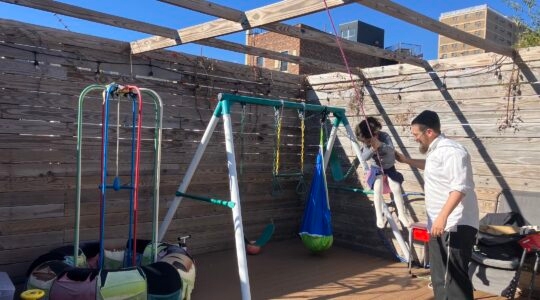Search through all other printed English-Yiddish dictionaries for words like “texting,” “transgender,” and “food coma,” and you won’t find them.
That’s where Gitl Schaechter-Viswanath, Yiddish language editor for Afn shvel magazine and a published Yiddish poet, comes in. This past June, Indiana University Press in conjunction with the League for Yiddish published the Comprehensive English-Yiddish Dictionary, the first English-Yiddish dictionary published since 1968. Editors Schaechter-Viswanath and Paul Glasser wanted to provide a comprehensive dictionary that reflects changes in language and modern terminology.
“Yiddish students, teachers and speakers all over will now be able to access thousands of words and expressions not found in previous English-Yiddish dictionaries,” wrote Schaechter-Viswanath in an email interview with the Jewish Week.
The project was started by Schaechter-Viswanath’s father, Dr. Mordkhe Schaechter, a Yiddish linguist, philologist and lexicographer who spent much of his life collecting words and teaching Yiddish at Columbia University and the YIVO Institute for Jewish Research.
“Whenever he would hear an interesting Yiddish word from a native Yiddish speaker, or read it in the literature, or in any of the dozens of Yiddish newspapers that he read voraciously, he would whip out his ubiquitous pack of index cards and write it down, with its English translation,” Schaechter-Viswanath wrote to the Jewish Week. “These cards made up the foundation of his 87 card catalogues and shoeboxes.”
As a teenager, Schaechter-Viswanath helped her father organize these files; as an adult she computerized the collection.
“After years of working with him as a colleague, co-editor and general assistant, I was involved from day one when – already in his 70s – he embarked on what would have been his life’s work: a new English-Yiddish dictionary for the 21st century,” wrote Schaechter-Viswanath. “This dictionary would contain all the words he had amassed, as well as the dozens of lexical collections (lists of terms for sports, physics, medicine, botany, music, cuisine, and many others) that he had documented.”
Dr. Mordkhe Schaechter began the dictionary project in 2000, but was unable to continue due to illness. That was when Schaechter-Viswanath took it upon herself to make her father’s lifelong project her own. From then on, Schaechter-Viswanath spent her free time working on this project, in addition to her day job as a nursing home consultant.
“I slogged through years of editing this raw collection, with no end in sight, since I needed to verify all the words based on other sources,” wrote Schaechter-Viswanath.
After several years of this work and discussions with the League for Yiddish (which had been founded by her father), Schaechter-Viswanath drew other experts into her project, including her co-editor Dr. Paul Glasser, former dean at the YIVO Institute and associate editor Dr. Chava Lapin, Yiddish professor, scholar, and language expert.
After 16 years, Schaechter-Viswanath submitted the completed 826-page manuscript for publication. In its final version, the dictionary contained approximately 50,000 entries and 33,000 subentries, including a lot of contemporary terminology like “email” and “texting” and “laptop,” emphasizing Yiddish as a living language spoken around the world.
When Schaechter-Viswanath and Glasser could not find any existing equivalent in the Yiddish language for a given English word and after researching how that word is expressed in other languages, they would coin words on their own.
“It has been a combination of utter joy and disbelief,” Schaechter-Viswanath wrote about having the dictionary finally published after so many years of work. “After so many years and numerous rounds of editing, and so many emotional ups and downs related to the project, it’s just hard to believe that the book has finally come to see the light of day.”
According to Schaechter-Viswanath, the first run of 1,200 copies sold out in less than 6 months, and they are already selling through their second run of an additional 1,000 copies.
“This enthusiastic response was completely unexpected,” wrote Schaechter-Viswanath to the Jewish Week. “Assuming this trend continues, we plan on releasing a second edition, including additions and corrections.”
The New York Jewish Week brings you the stories behind the headlines, keeping you connected to Jewish life in New York. Help sustain the reporting you trust by donating today.




